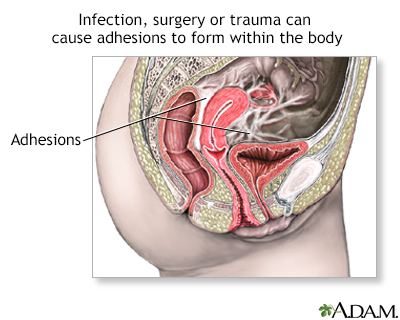Adhesion
Pelvic adhesion; Intraperitoneal adhesion; Intrauterine adhesion
Adhesions are bands of scar-like tissue that form between two surfaces inside the body and cause them to stick together.
Images

I Would Like to Learn About:
Causes
With movement of the body, internal organs such as the bowel or uterus are normally able to shift and to slide past each other. This is because these tissues and organs in the abdominal cavity have smooth, slippery surfaces. Inflammation (swelling), surgery, or injury can cause adhesions to form and prevent this movement. Adhesions can occur almost anywhere in the body, including:
- Joints, such as the shoulder
- Eyes
- Inside the abdomen or pelvis
Adhesions can become larger or tighter over time. Problems may occur if the adhesions cause an organ or body part to:
- Twist
- Pull out of position
- Be unable to move normally
The risk of forming adhesions is high after bowel or female organ surgeries. Surgery using a laparoscope is less likely to cause adhesions than open surgery.
Other causes of adhesions in the abdomen or pelvis include:
- Appendicitis, most often when the appendix breaks open (ruptures)
- Cancer
- Endometriosis
- Infections in the abdomen and pelvis, such as appendicitis or fallopian tube infection
- Radiation treatment
Adhesions around the joints may occur:
- After surgery or trauma
- With certain types of arthritis
- With overuse of a joint or tendon
Symptoms
Adhesions in joints, tendons, or ligaments make it harder to move the joint. They may also cause pain.
Adhesions in the belly (abdomen) may cause a blockage of the intestines. Symptoms include:
- Bloating or swelling of your belly
- Constipation
- Nausea and vomiting
- No longer being able to pass gas
- Pain in the belly that is severe and crampy
Adhesions in the pelvis may cause long-term (chronic) pelvic pain.
Exams and Tests
Most of the time, the adhesions cannot be seen using x-rays or imaging tests.
- Hysterosalpingography may help detect adhesions inside the uterus or fallopian tubes.
- X-rays of the abdomen, barium contrast studies, and CT scans may help detect a blockage of the intestines caused by adhesions.
Endoscopy (a way of looking inside the body using a flexible tube that has a small camera on the end) may help diagnose adhesions:
- Hysteroscopy looks inside the uterus
- Laparoscopy looks inside the abdomen and pelvis
Treatment
Surgery may be done to separate the adhesions. This can let the organ regain normal movement and reduce symptoms. However, the risk for more adhesions goes up with more surgeries.
Depending on the location of the adhesions, a barrier may be placed at the time of surgery to help reduce the chance of the adhesions returning.
Outlook (Prognosis)
The outcome is good in most cases.
Possible Complications
Adhesions can cause various disorders, depending on the tissues affected.
- In the eye, adhesion of the iris to the lens can lead to glaucoma.
- In the intestines, adhesions can cause partial or complete bowel obstruction.
- Adhesions inside the uterine cavity can cause a condition called Asherman syndrome. This can cause a woman to have irregular menstrual cycles and be unable to get pregnant.
- Pelvic adhesions that involve scarring of the fallopian tubes can lead to infertility and reproductive problems.
- Abdominal and pelvic adhesions can cause chronic pain.
When to Contact a Medical Professional
Contact your health care provider if you have:
- Abdominal pain
- An inability to pass gas
- Nausea and vomiting that do not go away
- Pain in the belly that is severe and crampy
Related Information
AppendicitisGlaucoma
Intestinal obstruction and Ileus
Asherman syndrome
References
Kuemmerle JF. Inflammatory and anatomic diseases of the intestine, peritoneum, mesentery, and omentum. In: Goldman L, Cooney KA, eds. Goldman-Cecil Medicine. 27th ed. Philadelphia, PA: Elsevier; 2024:chap 128.
National Institute of Diabetes and Digestive and Kidney Diseases website. Abdominal adhesions. www.niddk.nih.gov/health-information/digestive-diseases/abdominal-adhesions. Updated June 2019. Accessed June 3, 2024.
Yepuri N, Pruekprasert N. Cooney RN. Surgical complications. In: Townsend CM Jr, Beauchamp RD, Evers BM, Mattox KL, eds. Sabiston Textbook of Surgery. 21st ed. St Louis, MO: Elsevier; 2022:chap 12.
BACK TO TOPReview Date: 3/31/2024
Reviewed By: LaQuita Martinez, MD, Department of Obstetrics and Gynecology, Emory Johns Creek Hospital, Alpharetta, GA. Also reviewed by David C. Dugdale, MD, Medical Director, Brenda Conaway, Editorial Director, and the A.D.A.M. Editorial team.

Health Content Provider
06/01/2025
|
A.D.A.M., Inc. is accredited by URAC, for Health Content Provider (www.urac.org). URAC's accreditation program is an independent audit to verify that A.D.A.M. follows rigorous standards of quality and accountability. A.D.A.M. is among the first to achieve this important distinction for online health information and services. Learn more about A.D.A.M.'s editorial policy, editorial process and privacy policy. A.D.A.M. is also a founding member of Hi-Ethics. This site complied with the HONcode standard for trustworthy health information from 1995 to 2022, after which HON (Health On the Net, a not-for-profit organization that promoted transparent and reliable health information online) was discontinued. |
The information provided herein should not be used during any medical emergency or for the diagnosis or treatment of any medical condition. A licensed medical professional should be consulted for diagnosis and treatment of any and all medical conditions. Links to other sites are provided for information only -- they do not constitute endorsements of those other sites. © 1997- 2025 A.D.A.M., a business unit of Ebix, Inc. Any duplication or distribution of the information contained herein is strictly prohibited.
